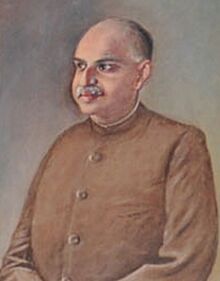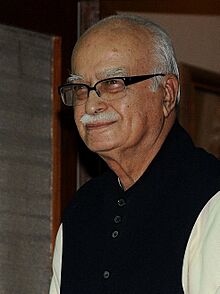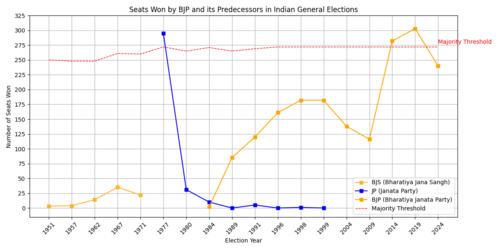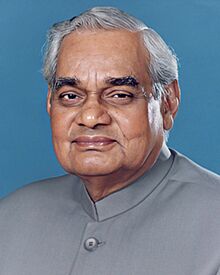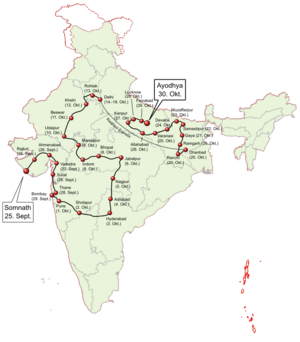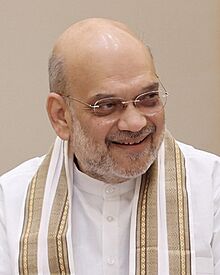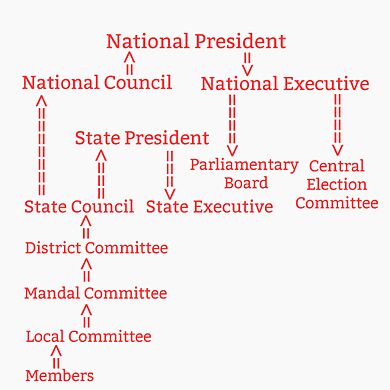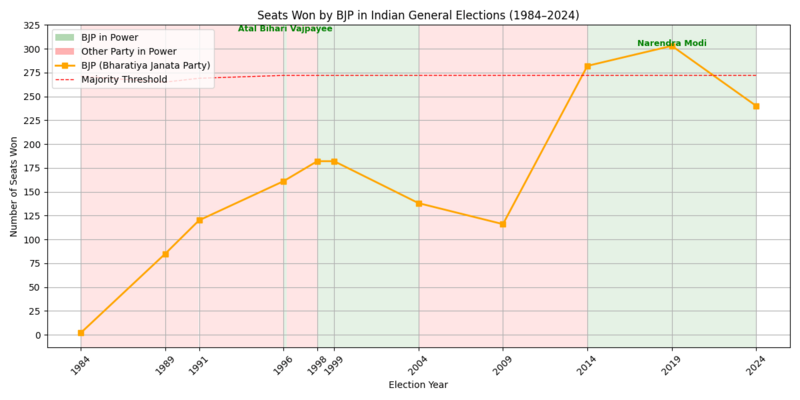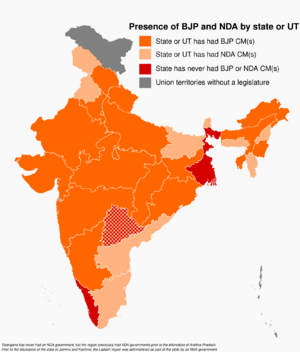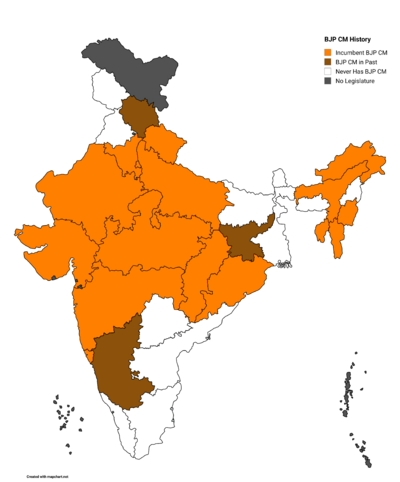Bharatiya Janata Party facts for kids
Quick facts for kids
Bharatiya Janata Party
|
|
|---|---|
| Abbreviation | BJP |
| President | J. P. Nadda |
| Parliamentary Chairperson | Narendra Modi (Prime Minister) |
| Lok Sabha leader | Narendra Modi (Leader of the House in Lok Sabha) |
| Rajya Sabha leader | J. P. Nadda (Leader of the House in Rajya Sabha) |
| Founder |
|
| Founded | 6 April 1980 |
| Split from | Janata Party |
| Preceded by |
|
| Headquarters | 6-A, Deen Dayal Upadhyaya Marg, New Delhi, Delhi, India |
| Newspaper |
|
| Youth wing | Bharatiya Janata Yuva Morcha |
| Women's wing | BJP Mahila Morcha |
| Labour wing | Bharatiya Mazdoor Sangh (unofficial) |
| Peasant's wing | BJP Kisan Morcha |
| Ideology | |
| Political position | Right-wing to far-right |
| International affiliation | Asia Pacific Democracy Union |
| Colours | Saffron |
| ECI Status | National Party |
| Alliance |
|
| Seats in Lok Sabha |
240 / 543
(542 MPs and 1 vacant) |
| Seats in Rajya Sabha |
102 / 245
(240 MPs and 5 vacant) |
| Seats in State Legislative Assemblies |
1,656 / 4,126
(4118 MLAs and 8 vacant; complete list) |
| Seats in State Legislative Councils |
165 / 426
(403 MLCs and 23 vacant; complete list) |
| Number of states and union territories in government |
20 / 31
(28 States and 3 UTs) |
| Election symbol | |
 |
|
| Party flag | |
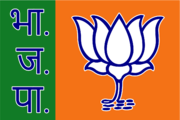 |
|
The Bharatiya Janata Party (BJP) is a major political party in India. Its name means "Indian People's Party." It is one of the two biggest parties in India, along with the Indian National Congress. The BJP grew out of an older party called the Bharatiya Jana Sangh. Since 2014, the BJP has been the ruling party in India, led by Prime Minister Narendra Modi.
The BJP is known for its right-wing politics, which means it often supports traditional values and less government involvement in the economy. It has strong ties to the Rashtriya Swayamsevak Sangh (RSS), a group that promotes Hindu nationalism. The BJP's main idea is called Hindutva, which focuses on Hindu cultural identity. As of early 2024, the BJP is the largest political party in India. It has the most members in the Parliament of India and in state governments.
The party's story began with the Bharatiya Jana Sangh, started in 1951 by Syama Prasad Mookerjee. After a period of emergency rule in India (1975–1977), the Jana Sangh joined with other parties to form the Janata Party. This new party won the 1977 election. However, the Janata Party broke up in 1980. Members from the old Jana Sangh then formed the modern-day BJP.
At first, the BJP was not very successful. It won only two seats in the 1984 election. But it gained strength by supporting a movement to build a temple at Ram Janmabhoomi in Uttar Pradesh. After winning more state and national elections, the BJP became the largest party in Parliament in 1996. However, its government, led by Atal Bihari Vajpayee, lasted only 13 days because it did not have enough support.
After the 1998 election, the BJP formed a group of parties called the National Democratic Alliance (NDA). Vajpayee became Prime Minister again. This government lasted for a year. After new elections, the NDA, still led by Vajpayee, stayed in power for a full five-year term. This was the first time a non-Congress government completed its full term. In 2004, the NDA lost the election, and the BJP became the main opposition party for ten years.
In 2014, Narendra Modi, who was then the chief minister of Gujarat, led the BJP to a big victory. Modi has been India's Prime Minister since then. He was re-elected with a strong majority in 2019 and with a coalition in 2024. As of late 2023, the NDA alliance governs 17 Indian states and union territories.
The BJP's official idea is "integral humanism." This idea was developed by Deendayal Upadhyaya in 1965. The party supports traditional social values and a foreign policy that puts India's interests first. When the BJP first led the national government, it focused on economic growth and opening up the economy. Since 2014, the BJP government has worked on some of the RSS's goals. These include making the practice of triple talaq illegal and changing Article 370 of the Constitution of India, which gave special powers to Jammu and Kashmir.
Contents
Party Name, Symbol, and Colors
The founders of the party chose its name and symbol. "Bharatiya Janata Party" means "Indian People's Party." The party's symbol is the Lotus flower. The lotus is important in Indian culture and Hinduism. It is seen as a symbol of peace and good fortune. During India's fight for independence, the lotus was also a symbol of protest against British rule. The lotus is also India's national flower. Using this symbol helps the party connect with Indian national pride and Hindu beliefs.
The BJP also uses the color saffron a lot in its materials and campaigns. Saffron is also very important in Hinduism. The party's flag is mostly saffron with a green stripe on the left. The lotus symbol is also on the saffron part of the flag. This design helps the party appear open to all religions while still appealing to its main supporters and groups that follow Hindutva.
How the Party Started
Bharatiya Jana Sangh (1951–1977)
The BJP's roots are in the Bharatiya Jana Sangh, or Jana Sangh. Syama Prasad Mookerjee founded it in 1951. He wanted to create a party that would stand against the powerful National Congress party. The Jana Sangh worked closely with the Rashtriya Swayamsevak Sangh (RSS), a group that promotes Hindu ideas. Many people saw the Jana Sangh as the political arm of the RSS.
The Jana Sangh wanted to protect India's Hindu culture. It also aimed to challenge what it saw as unfair treatment of Muslim people and Pakistan by the Congress party. The RSS sent many of its full-time workers, called pracharaks, to help start the new party. Deendayal Upadhyaya became the General Secretary. In the first general elections in 1952, the Jana Sangh won only three seats in the Lok Sabha (the lower house of Parliament). It remained a small party in Parliament until 1967.
In 1953, the Jana Sangh started a campaign to fully include Jammu and Kashmir into India. Mookerjee was arrested for entering Kashmir without permission and died in jail. Upadhyaya then became the General Secretary and worked to build the party at the local level, like the RSS. Young leaders like Atal Bihari Vajpayee and Lal Krishna Advani also became important. Vajpayee became president in 1968. During this time, the party focused on creating common laws for all citizens, banning cow slaughter, and ending the special status of Jammu and Kashmir.
After state elections in 1967, the Jana Sangh joined with other parties to form governments in states like Madhya Pradesh, Bihar, and Uttar Pradesh. This was the first time the Jana Sangh held political power, even if it was in a group of parties. This made them put some of their more extreme ideas on hold.
Janata Party (1977–1980)
In 1975, Prime Minister Indira Gandhi declared a state of emergency. The Jana Sangh joined protests, and many of its members were jailed. In 1977, the emergency ended, and new elections were held. The Jana Sangh merged with other parties to form the Janata Party. Their main goal was to defeat Indira Gandhi.
The Janata Party won the 1977 election and formed a government with Morarji Desai as Prime Minister. The former Jana Sangh members made up the largest part of the Janata Party in Parliament. Atal Bihari Vajpayee, who had led the Jana Sangh, became the Minister of External Affairs.
The leaders from the old Jana Sangh tried to fit in with the Janata Party's ideas. However, the Jana Sangh members at the state and local levels remained strongly connected to the RSS. This caused problems with other parts of the Janata Party. Some members of the Janata Party demanded that the former Jana Sangh members leave the RSS, but they refused. Eventually, a part of the Janata Party broke away. The government lost its majority, and Desai resigned. New elections were held in 1980, and the Janata Party did not do well. In April 1980, the Janata Party banned its members from also being members of the RSS. Because of this, the former Jana Sangh members left and created the Bharatiya Janata Party.
Party History
Starting and Early Years
The new BJP was officially separate from the Jana Sangh, but most of its members were the same. Atal Bihari Vajpayee became its first president. In the early 1980s, there was a lot of violence between Hindus and Muslims. The BJP first tried to be more moderate to attract more people. It focused on ideas like Gandhian socialism. This did not work well. In the 1984 elections, the BJP won only two seats in the Lok Sabha. The assassination of Indira Gandhi shortly before the election led to a huge wave of support for the Congress party.
Ram Janmabhoomi Movement
Because Vajpayee's moderate approach didn't work, the party shifted to a stronger Hindutva stance. In 1984, Advani became the party president. Under his leadership, the BJP became the main political voice for the Ram Janmabhoomi movement. In the early 1980s, a group called the Vishva Hindu Parishad (VHP) started a campaign. They wanted to build a temple for the Hindu god Rama at the site of the Babri Mosque in Ayodhya. People believed this site was Rama's birthplace and that a temple had been destroyed to build the mosque. The BJP strongly supported this campaign and made it a key part of their election promises. In 1989, they won 86 seats in the Lok Sabha. This made their support very important for the government led by V. P. Singh.
In September 1990, Advani started a Rath Yatra (chariot journey) to Ayodhya to support the temple movement. This journey used strong religious and nationalist symbols. Advani was arrested, but many religious volunteers still gathered in Ayodhya. Some attacked the mosque. After clashes with police, several volunteers died. The VHP urged Hindus to "take revenge," leading to riots against Muslims in Uttar Pradesh. The BJP then stopped supporting the V.P. Singh government, which led to new elections. The BJP won even more seats, reaching 120, and also won a majority in the Uttar Pradesh state assembly.
On December 6, 1992, the RSS and its related groups held a large rally at the mosque site. Over 100,000 activists were there. The rally turned into an attack, and the mosque was torn down. In the following weeks, violence between Hindus and Muslims broke out across India, killing over 2,000 people. The government briefly banned the VHP, and many BJP leaders, including Advani, were arrested. Many historians believe the demolition was planned. In the 1996 elections, the BJP used the strong feelings from the demolition to win 161 Lok Sabha seats, becoming the largest party. Vajpayee became Prime Minister but could not get enough support, so his government resigned after 13 days.
A report in 2009 said that 68 people, mostly BJP leaders, were responsible for the demolition. These included Vajpayee, Advani, and Murli Manohar Joshi. The report also criticized Kalyan Singh, the Chief Minister of Uttar Pradesh at the time. In 2020, the Supreme Court of India cleared all the accused, including Advani and Joshi.
After a 2019 Supreme Court decision, the Government of India announced a trust to build the temple. On January 22, 2024, the Ram Mandir officially opened. Prime Minister Narendra Modi led the opening ceremony, calling it the start of a new era. The temple is expected to be fully finished by September 2025.
Vajpayee and Advani Years (1996–2004)
After a short-lived government by other parties, new elections were held in 1998. The BJP ran as part of the National Democratic Alliance (NDA), a group of different parties. The NDA won enough seats with support from the Telugu Desam Party (TDP). Vajpayee became Prime Minister again. However, the alliance broke apart in May 1999, leading to more elections.
On October 13, 1999, the NDA won 303 seats in Parliament, giving them a clear majority. The BJP itself won 182 seats, its highest number ever at that time. Vajpayee became Prime Minister for the third time. Advani became Deputy Prime Minister and Home Affairs Minister. This NDA government completed its full five-year term. Their policies included a stronger focus on defense and fighting terrorism, and economic policies that encouraged free markets. In 2001, Bangaru Laxman, then the BJP president, was caught accepting a bribe and had to resign.
2002 Gujarat Events
On February 27, 2002, a train carrying Hindu pilgrims caught fire near Godhra, killing 59 people. This event was seen as an attack on Hindus and led to widespread violence against Muslims in the state of Gujarat for several weeks. Many people were killed, and thousands were forced to leave their homes. The chief minister of Gujarat at the time, Narendra Modi, and some government officials were accused of not doing enough to stop the violence. In 2009, the Supreme Court appointed a special team to investigate. In 2012, Modi was cleared of involvement by this team. A BJP state politician, Maya Kodnani, was found guilty of organizing one of the violent events but was later cleared by a higher court.
In Opposition (2004–2014)
Vajpayee called for early elections in 2004. The NDA's campaign used the slogan "India Shining" to show how the country was growing economically. However, the NDA lost unexpectedly, winning only 186 seats compared to the Congress and its allies, who won 222. Manmohan Singh became Prime Minister. Many people thought the NDA lost because it didn't connect with people in rural areas and focused too much on its business supporters.
In May 2008, the BJP won state elections in Karnataka. This was the first time the party won elections in a southern Indian state. In the 2009 general elections, the BJP's seats in the Lok Sabha dropped to 116. This was Advani's last election as leader. The party was then led by Arun Jaitley in the Rajya Sabha and Sushma Swaraj in the Lok Sabha for the next five years. They lost the Karnataka state election in 2013.
Modi Era (2014–Present)
In the 2014 Indian general election, the BJP won 282 seats. This led the NDA to a total of 336 seats in the 543-seat Lok Sabha. Narendra Modi became the 14th Prime Minister of India on May 26, 2014. The BJP won 31% of all votes, which was a low percentage for the number of seats they won. This was the first time since 1984 that a single party won a clear majority in the Indian Parliament. Most experts did not predict such a big victory.
Experts believe several things led to this win. These include Modi's popularity and the Congress party losing support due to past issues. The BJP also gained support from middle-class people and other groups, not just its traditional supporters. However, its support among Muslims remained low. The BJP was also very good at getting its supporters to vote.
After winning the election, the BJP became more centralized under Modi's leadership. People loyal to Modi were given important positions in different states. Amit Shah, a close friend of Modi, became the president of the BJP in 2014. Many older leaders of the party, like Lal Krishna Advani and Murli Manohar Joshi, were reportedly sidelined.
During Modi's first term as Prime Minister, the BJP grew stronger in many states where it used to be a small party. It also regained power in other states where it had been in opposition. States like Assam, Tripura, Uttar Pradesh, and Bihar saw the BJP's influence grow.
In 2019, the BJP won the general election with an even bigger majority. Soon after, on August 5, 2019, Modi's government changed the special status of Jammu and Kashmir. This region had been given limited self-rule under Article 370 of the Constitution of India. The government also changed Jammu and Kashmir from a state into two smaller areas called union territories.
Later in 2019, the Modi government introduced the Citizenship (Amendment) Act, 2019. This law made it easier for illegal immigrants who were Hindus, Sikhs, Buddhists, Jains, Parsis, or Christians and had fled persecution from Pakistan, Bangladesh, and Afghanistan before December 2014 to become Indian citizens. However, Muslims from those countries were not given the same chance. This was the first time religion was openly used as a reason for citizenship in Indian law. This law received global criticism and led to widespread protests, which stopped due to the COVID-19 pandemic. Some studies have said that India has seen a decline in democracy under the BJP's rule since 2014.
Party Ideas and Stances
The BJP has often been described as a right-wing party. More recently, it has increasingly been called far-right.
Social Policies and Hindutva
The BJP's main idea is "Integral humanism." This idea was developed by Deendayal Upadhyaya in 1965. It focuses on putting human beings at the center of economic models. The party is also committed to Hindutva, an idea from Vinayak Damodar Savarkar. The party says Hindutva is about Indian culture, not just religion, and applies to all Indians. However, many experts say Hindutva tries to make India a Hindu country, excluding other religions. When the BJP formed the NDA in 1998, it softened its stance because it was working with parties that had different ideas.
The BJP's Hindutva ideas have influenced many of its government policies. It supports building the Ram Mandir temple at the disputed site of the Babri Mosque. This was a major election promise in 1991. However, the demolition of the mosque in 1992 during a BJP rally caused problems for the party. The NDA government also changed school textbooks, which some scholars said was an attempt to promote Hindu nationalist views in Indian history. They also introduced Hindu astrology as a subject in colleges, despite scientists' objections.
The connection between the BJP and the RSS grew stronger under the Modi government. The RSS helped the BJP in elections. The Modi government also appointed many people linked to the RSS to important government jobs. In 2014, Yellapragada Sudershan Rao, who was connected to the RSS, became the head of the Indian Council of Historical Research (ICHR). Some historians questioned his qualifications. The Modi government also changed history textbooks to highlight Modi's role and show Indian society as always peaceful.
The BJP supports a uniform civil code. This would mean one set of personal laws for all citizens, regardless of their religion. Currently, laws vary by religious community. The BJP also supported, and in 2019 enacted, the removal of Article 370 of the Constitution of India. This article gave special powers to Jammu and Kashmir. At the same time, it changed Jammu and Kashmir from a state into two union territories.
The BJP is against illegal immigration from Bangladesh. The party says this migration threatens India's security and economy. Experts point out that the BJP calls Hindu migrants from Bangladesh "refugees" but calls Muslim migrants "illegal." The Modi government passed a citizenship law in 2019. This law offered Indian citizenship to persecuted religious minorities (Hindus, Sikhs, Buddhists, Jains, Parsis, or Christians) from Afghanistan, Bangladesh, and Pakistan. However, it did not offer the same to Muslims. This was the first time religion was openly used as a reason for citizenship in Indian law. It led to global criticism and widespread protests.
In 2013, the Supreme Court of India brought back a law that made homosexuality a crime. The BJP president at the time, Rajnath Singh, said the party supported this law because they believed homosexuality was unnatural. However, the party softened its stance after winning the 2014 elections. The Modi government is against same-sex marriage. They stated that legalizing it would disrupt traditional Indian family ideas.
Economic Policies
The BJP's economic policies have changed a lot over time. In the 1980s, like the Jana Sangh, it supported local industries and protecting them from foreign competition. However, it supported opening up the economy within India. When the BJP was in government from 1996 onwards, it moved away from protectionism and towards globalisation. During the NDA's time in power, many foreign companies came to India. Some of the BJP's own groups criticized this, saying the party was not sticking to its original ideas.
The NDA governments (1998–2004) reduced government control and sold off some government-owned businesses. They also lowered taxes on imports. These changes built on earlier economic reforms. India's economic growth increased a lot during the NDA's time. The 2004 campaign slogan "India Shining" was based on the idea that free markets would bring wealth to everyone. After their unexpected loss, some said the party was punished for ignoring the poor and focusing too much on businesses.
The Modi government's economic policies have focused on selling government assets and opening up the economy, based on a neoliberal approach. Modi made it easier for foreign companies to invest in India, including in defense and railways. Some proposed changes would have made it harder for workers to form unions, but these were dropped after protests. Unions strongly opposed these reforms. The Bharatiya Mazdoor Sangh, a group linked to the BJP, said the labor reforms favored businesses over workers. Modi has also been described as taking a more populist approach on healthcare and farming. In his second term, Modi's government has also focused more on national self-sufficiency.
Defense and Counterterrorism
The BJP has a more aggressive and nationalist view on defense and terrorism compared to the Congress party. The Vajpayee-led NDA government conducted nuclear weapons tests and passed a law to fight terrorism, which later faced criticism. They also sent troops to remove intruders from Kargil and supported the United States' fight against terrorism.
Even though previous governments could have tested nuclear weapons, the Vajpayee government decided to do so. They carried out Pokhran-II, a series of five nuclear tests in 1998. These tests happened soon after Pakistan tested a missile. They were seen as a way to show India's military strength and reflected anti-Pakistan feelings within the BJP.
The Vajpayee government ordered the Indian army to remove Pakistani soldiers from Kashmir territory. This event became known as the Kargil War. Although the government was later criticized for not knowing about the Pakistani presence earlier, they successfully removed them.
After a terrorist attack on the Indian Parliament in December 2001, the NDA government passed the Prevention of Terrorism Act. This law aimed to help the government deal with terrorism better. It was later criticized for limiting civil liberties and for being used against Muslims. The Congress-led government repealed it in 2004.
The Modi government has carried out several strikes in neighboring countries to fight terrorism. These include an operation in Myanmar in 2015, a strike in Pakistan-administered Kashmir in 2016, and an airstrike in Pakistan in 2019. It also helped Bhutan during a standoff with China in 2017.
The Modi government sees national security as a key focus. In August 2019, they created the position of Chief of Defence Staff (CDS). This was to improve coordination between the army, navy, and air force, a change many had wanted since the 1999 Kargil War.
Foreign Policy
The BJP's historical view on foreign policy, like the Bharatiya Jana Sangh, was based on strong Hindu nationalist ideas and protecting the economy. The Bharatiya Jana Sangh was founded to reverse the partition of India. So, its official view was that Pakistan's existence was not right. This strong feeling against Pakistan still influences the BJP's ideas. During the Cold War, the party was against India's policy of not taking sides and wanted closer ties with the United States. After the Cold War, the party has mostly agreed with India's foreign policy of improving relations with the United States.
The Vajpayee government's foreign policy was a big change from the BJP's usual ideas, though it kept some parts. It was also different from the earlier governments' focus on idealism, choosing a more realistic approach. His party criticized him for being too moderate with Pakistan. In 1998, he made an important visit to Pakistan and started a bus service between Delhi and Lahore. Vajpayee signed the Lahore Declaration to improve relations after the 1998 nuclear tests. However, Pakistani soldiers were found in Kashmir a few months later, leading to the 1999 Kargil War. The war ended with the removal of the intruders, but the border did not change. Despite the war, Vajpayee still wanted to talk with Pakistan. This was not popular with some BJP members, who thought the government was "weak."
The Vajpayee government strongly opposed the 1999 NATO bombing of Yugoslavia. Vajpayee called it a "dance of destruction." The Vajpayee government later supported the U.S. War on Terror. They hoped this would help India deal with terrorism in Kashmir. This led to closer defense ties with the U.S. However, the BJP strongly condemned the 2003 invasion of Iraq, saying it was "unjustified." In 2005, the BJP opposed a nuclear agreement with the U.S. that would limit India's nuclear program. The BJP also opposed the 2011 military action in Libya.
The Modi government first tried to improve relations with Pakistan, with Modi even visiting Pakistan in 2015. However, relations worsened after 2017. The Modi government has since taken a "hardline" approach to Pakistan. In 2015, the Nepalese government accused the Modi government of blocking goods from entering Nepal. The Modi government expressed concern after the 2021 Myanmar coup but kept good relations with the military government. It did not vote on a United Nations resolution about the situation there. The Modi government has remained neutral on the Russo-Ukrainian War, not voting on a UN resolution that condemned Russia's invasion of Ukraine.
Party Structure
The BJP has a clear leadership structure. The president is the highest authority. Until 2012, a president could serve one three-year term. Now, they can serve a maximum of two terms.
Below the president is the National Executive. This group includes many senior leaders from across the country. It is the main decision-making body of the party. It has several vice-presidents, general-secretaries, treasurers, and secretaries who work directly with the president. The same structure exists at the state, regional, district, and local levels.
The BJP is a party that relies on its members and workers. It has strong connections with other groups that share similar ideas, like the RSS. The members of these groups often help the BJP. Its lower-level members mostly come from the RSS and its related groups, known as the Sangh Parivar. These include:
- The Akhil Bharatiya Vidyarthi Parishad (All India Students' Union), for students.
- The Bharatiya Kisan Sangh (Indian Farmer's Union), for farmers.
- The Bharatiya Mazdoor Sangh (Indian Labourers Union), a labor union.
The party also has its own groups, such as:
- The BJP Mahila Morcha (BJP Women's Front), for women.
- The Bharatiya Janata Yuva Morcha (Indian People's Youth Front), for youth.
- The BJP Minority Morcha (BJP Minority Front), for minorities.
The BJP says it has over 170 million members as of October 2022. This makes it one of the largest political parties in the world. In September 2024, Prime Minister Modi started a BJP membership drive. This campaign has faced some criticism for how members were enrolled. For example, in Gujarat, some minor school children were reportedly signed up as BJP members.
General Election Results
The Bharatiya Janata Party was founded in 1980. Its first general election was in 1984, where it won only two seats in the Lok Sabha. In the 1996 election, the BJP became the largest party in the Lok Sabha for the first time, but its government did not last long. In the 1998 and 1999 elections, it remained the largest party and led the ruling group of parties. In the 2014 general election, it won a clear majority in Parliament. Since 1991, a BJP member has led the Opposition whenever the party was not in power.
| Year | Legislature | Party leader | Seats contested | Seats won | Change in seats | Percentage of votes |
Vote swing | Outcome | Ref. |
|---|---|---|---|---|---|---|---|---|---|
| 1984 | 8th Lok Sabha | Atal Bihari Vajpayee | 229 |
2 / 543
|
7.74% | New | Opposition | ||
| 1989 | 9th Lok Sabha | Lal Krishna Advani | 225 |
85 / 543
|
11.36% | Outside support for NF | |||
| 1991 | 10th Lok Sabha | 477 |
120 / 543
|
20.11% | Official Opposition | ||||
| 1996 | 11th Lok Sabha | Atal Bihari Vajpayee | 471 |
161 / 543
|
20.29% | Coalition (1996) | |||
| Official Opposition (1996–97) | |||||||||
| 1998 | 12th Lok Sabha | 388 |
182 / 543
|
25.59% | Coalition | ||||
| 1999 | 13th Lok Sabha | 339 |
182 / 543
|
23.75% | Coalition | ||||
| 2004 | 14th Lok Sabha | Lal Krishna Advani | 364 |
138 / 543
|
22.16% | Official Opposition | |||
| 2009 | 15th Lok Sabha | 433 |
116 / 543
|
18.80% | Official Opposition | ||||
| 2014 | 16th Lok Sabha | Narendra Modi | 428 |
282 / 543
|
31.34% | Majority | |||
| 2019 | 17th Lok Sabha | 436 |
303 / 543
|
37.46% | Majority | ||||
| 2024 | 18th Lok Sabha | 441 |
240 / 543
|
36.56% | Coalition |
| All time-BJP Lok Sabha seat count |
|
EasyTimeline 1.90
|
BJP in States and Union Territories
The BJP has held power in states like Karnataka, Jharkhand, and Himachal Pradesh. It has also been a smaller partner in governments in Jammu and Kashmir, Punjab, and Tamil Nadu. The party has never held power in Kerala, Telangana, and West Bengal.
Besides the NDA, the BJP is also part of a regional political group in Northeast India called the North-East Democratic Alliance.
| Lower House | |||
|---|---|---|---|
| Legislature | Seats | Legislative leader | Status |
| Andhra Pradesh |
8 / 175
|
Penmetsa Vishnu Kumar Raju | Coalition |
| Arunachal Pradesh |
46 / 60
|
Pema Khandu | Government |
| Assam |
64 / 126
|
Himanta Biswa Sarma | Government |
| Bihar |
82 / 243
|
Samrat Choudhary | Coalition |
| Chhattisgarh |
54 / 90
|
Vishnu Deo Sai | Government |
| Delhi |
48 / 70
|
Rekha Gupta | Government |
| Goa |
28 / 40
|
Pramod Sawant | Government |
| Gujarat |
161 / 182
|
Bhupendrabhai Patel | Government |
| Haryana |
48 / 90
|
Nayab Singh Saini | Government |
|
Himachal Pradesh |
28 / 68
|
Jai Ram Thakur | Opposition |
|
Jammu and Kashmir |
28 / 90
|
Sunil Kumar Sharma | Opposition |
|
Jharkhand |
21 / 81
|
Babulal Marandi | Opposition |
|
Karnataka |
66 / 224
|
R. Ashoka | Opposition |
|
Kerala |
0 / 140
|
No Representation | |
|
Madhya Pradesh |
165 / 230
|
Mohan Yadav | Government |
|
Maharashtra |
132 / 288
|
Devendra Fadnavis | Government |
|
Manipur |
37 / 60
|
TBD | President Rule |
|
Meghalaya |
2 / 60
|
Sanbor Shullai | Coalition |
|
Mizoram |
2 / 40
|
K. Beichhua | Others |
|
Nagaland |
12 / 60
|
Y. Patton | Coalition |
|
Odisha |
78 / 147
|
Mohan Charan Majhi | Government |
|
Puducherry |
9 / 33
|
A. Namassivayam | Coalition |
|
Punjab |
2 / 117
|
Ashwani Kumar Sharma | Others |
|
119 / 200
|
Bhajan Lal Sharma | Government | |
|
Sikkim |
0 / 32
|
No Representation | Alliance |
|
Tamil Nadu |
4 / 234
|
Nainar Nagendran | Opposition |
|
Telangana |
8 / 119
|
Alleti Maheshwar Reddy | Others |
|
Tripura |
33 / 60
|
Manik Saha | Government |
|
Uttar Pradesh |
258 / 403
|
Yogi Adityanath | Government |
|
Uttarakhand |
47 / 70
|
Pushkar Singh Dhami | Government |
|
West Bengal |
65 / 294
|
Suvendu Adhikari | Opposition |
| Upper House | |||
| Rajya Sabha |
99 / 245
|
J. P. Nadda | Government |
| Andhra Pradesh |
1 / 58
|
Somu Veerraju | Coalition |
| Bihar |
24 / 75
|
Hari Sahni | Government |
|
Karnataka |
30 / 75
|
Chalavadi Narayanaswamy | Opposition |
|
Maharashtra |
22 / 78
|
Pravin Darekar | Government |
|
Telangana |
3 / 40
|
A.Venkata Narayana Reddy | Others |
|
Uttar Pradesh |
79 / 100
|
Keshav Prasad Maurya | Government |
List of Heads of Government
List of Prime Ministers
| No. | Portrait | Prime minister | Constituency | Term in office | Lok Sabha | Cabinet | ||
|---|---|---|---|---|---|---|---|---|
| Start | End | Tenure | ||||||
| 1 | 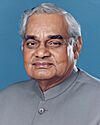 |
Atal Bihari Vajpayee | Lucknow | 16 May 1996 | 1 June 1996 | 16 days | 11th | Vajpayee I |
| 19 March 1998 | 22 May 2004 | 6 years, 64 days | 12th | Vajpayee II | ||||
| 13th | Vajpayee III | |||||||
| 2 | 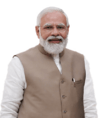 |
Narendra Modi | Varanasi | 26 May 2014 | Incumbent | 11 years, 200 days | 16th | Modi I |
| 17th | Modi II | |||||||
| 18th | Modi III | |||||||
List of Current Chief Ministers
As of early 2025, 55 people from the Bharatiya Janata Party have served as chief ministers. 14 of them are currently in office.
| No. | State | Portrait | Name | Cabinet | Governing coalition | |
|---|---|---|---|---|---|---|
| 1 | Arunachal Pradesh |  |
Pema Khandu | Khandu V | BJP | |
| NPP | ||||||
| 2 | Assam |  |
Himanta Biswa Sarma | Sarma I | BJP | |
| AGP | ||||||
| UPPL | ||||||
| 3 | Chhattisgarh |  |
Vishnudeo Sai | Sai I | BJP | |
| 4 | Delhi |  |
Rekha Gupta | Gupta | BJP | |
| 5 | Goa |  |
Pramod Sawant | Sawant II | BJP | |
| MGP | ||||||
| IND | ||||||
| 6 | Gujarat |  |
Bhupendrabhai Patel | Patel II | BJP | |
| 7 | Haryana |  |
Nayab Singh Saini | Saini II | BJP | |
| 8 | Madhya Pradesh |  |
Mohan Yadav | Yadav I | BJP | |
| 9 | Maharashtra |  |
Devendra Fadnavis | Fadnavis III | BJP | |
| SHS | ||||||
| NCP | ||||||
| JSS | ||||||
| RSP | ||||||
| RYSP | ||||||
| RSVA | ||||||
| IND | ||||||
| 10 | Manipur | - | - | - | BJP | |
| NPP | ||||||
| NPF | ||||||
| IND | ||||||
| 11 | Odisha |  |
Mohan Charan Majhi | Majhi I | BJP | |
| 12 | Rajasthan |  |
Bhajan Lal Sharma | Sharma I | BJP | |
| 13 | Tripura |  |
Manik Saha | Saha II | BJP | |
| IPFT | ||||||
| 14 | Uttar Pradesh |  |
Yogi Adityanath | Adityanath II | BJP | |
| AD(S) | ||||||
| RLD | ||||||
| NP | ||||||
| 15 | Uttarakhand |  |
Pushkar Singh Dhami | Dhami II | BJP | |
See also
 In Spanish: Partido Popular Indio para niños
In Spanish: Partido Popular Indio para niños
- Leader of the Bharatiya Janata Party in the Parliament of India
- List of political parties in India
- List of presidents of the Bharatiya Janata Party
- List of state presidents of the Bharatiya Janata Party
- Organisation of the Bharatiya Janata Party
- Politics of India
- List of ruling political parties by country



